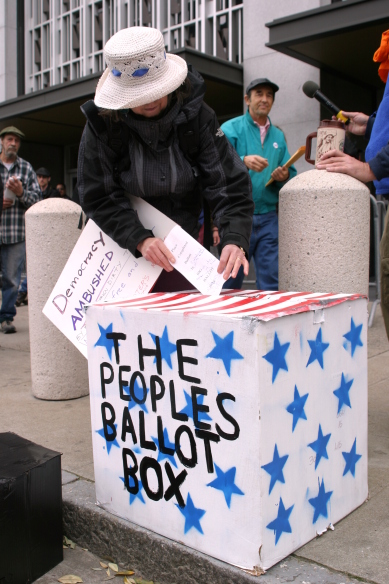
I've been participating in a program called Call For Change, organized by MoveOn Political Action. I've hosted house parties at my house, where people come over with their cell phones and call voters in other districts, as a part of a massive, nationwide Get Out The Vote (GOTV) effort. This effort continues through the close of polling today, which I plan on participating in. I encourage you to do the same, if you're reading this on Election Day:

However, there have been reports and indications that the Republicans have conspired to steal the 2006 election by denying the right to vote to Jews, Hispanics and Blacks in contested districts throughout the country. They've slipped in language to a federal vote-reform bill that requires voter rolls to be matched from the local level to the federal level -- and then did not update the federal rolls in a timely manner. Where it is legal to require photo ID at voting precincts, the names must match *exactly*, and Republican lawyers will be out en force at the polls to attempt to deny the vote to targeted groups for any possible reason, including mis-match of names on IDs (I'm guessing that this could be stuff like having an initial for a middle name, rather than the entire thing spelled out. Or, for Hispanics, only including one rather than both surnames).
The full story is re-printed here (below), because the
link to the original is only up sporadically. I don't agree with the conclusions of the author, however (he says that if Democrats can't win with greater than 51% of the vote, they don't deserve to, and if they can get greater than a 2% lead, they will win). I'm certain that the Republicans, if they are engaging in this sort of election-rigging, will target it in those races where it will make the most difference, and they will shoot for denying more like 10-20% of the vote in these districts -- which may then give the appearance of them winning by only 1-2%.
I'm hoping that the MoveOn and other GOTV efforts will prevail over these Republican dirty tricks, but this article sure isn't very inspirational towards that hope. So, to counter the bad news from the Republican front, here's some good news, in the form of inspirational quotes, from MoveOn:
"I'm writing to tell you that the Democratic candidates in the tightest, neck-to-neck races in the country are counting on you to pull them through to victory with the energy, spirit and passion that define MoveOn."—Bill Clinton(1)
"This morning, I joined the team and made some calls...I know it's easy to feel like your calls will be drops in a political ocean. I'm here to tell you that they're not. I know a thing or two about close races where a few hundred "drops" make all the difference. And the margins in many of these races are even closer. You could personally turn out the voter who tips the balance."—Al Gore(2)
"Through Call for Change, you're reaching out to folks who have been told they should keep quiet for so long, they almost believe it. They want a different direction for our country, but they've been disappointed, and ignored, and they need a reason to hope. You're calling to give them that reason—to let them know that this week, their vote has the power to turn it all around."—John Edwards(3)
"As a disabled veteran who is greatly affected by this administration's failure to properly fund VA health care and mental health programs for active duty troops and veterans, I urgently ask all my readers to help work for change in America."—MoveOn blogger Mike(4)
"I don't normally post politically themed topics, but this is too important to not talk about. This election day, on Nov. 7, the Democrats have a solid chance of taking back Congress...Help MoveOn.org and sign up as a volunteer to call people and make sure they get out to the polls."—MoveOn blogger Ari(5)
"In the most sophisticated phone banking program ever produced in American politics, MoveOn.org has created a program to call [five] million key voters in 50 key House districts and more than half a dozen Senate campaigns...it is amazing stuff."—Chris Bowers, MyDD(6)
Sources:
1. Bill Clinton's letter to MoveOn members, November 6, 2006
http://pol.moveon.org/pac/call4change/clinton.html?id=9455-6713077-cpqbT.fSwf0JPCS7Gfdv_Q&t=13
2. Al Gore's letter to MoveOn members, November 2, 2006
http://pol.moveon.org/pac/call4change/Gore.html?id=9455-6713077-cpqbT.fSwf0JPCS7Gfdv_Q&t=14
3. John Edwards' letter to MoveOn members, November 4, 2006
http://pol.moveon.org/pac/call4change/edwards.html?id=9455-6713077-cpqbT.fSwf0JPCS7Gfdv_Q&t=15
4. "Time for Change for veterans and Congress," MoveOn blogger Mike, October 29, 2006
http://www.moveon.org/r?r=2217&id=9455-6713077-cpqbT.fSwf0JPCS7Gfdv_Q&t=16
5. "Call for Change," MoveOn blogger Ari, October 29, 2006
http://www.moveon.org/r?r=2218&id=9455-6713077-cpqbT.fSwf0JPCS7Gfdv_Q&t=17
6. "Call for Change," MyDD.com, October 18, 2006
http://www.mydd.com/story/2006/10/18/144555/18
And now for the bad news (skip reading this until after the election if you'd like):
HOW THEY STOLE THE MID-TERM ELECTION
Published by Greg Palast November 6th, 2006 in Articles
by Greg Palast
for The Guardian (UK), Comment is Free
Monday November 6, 2006
Here’s how the 2006 mid-term election was stolen.
Note the past tense. And I’m not kidding.
And shoot me for saying this, but it won’t be stolen by jerking with the touch-screen machines (though they’ll do their nasty part). While progressives panic over the viral spread of suspect computer black boxes, the Karl Rove-bots have been tunneling into the vote vaults through entirely different means.
For six years now, our investigations team, at first on assignment for BBC TV and the Guardian, has been digging into the nitty-gritty of the gaming of US elections. We’ve found that November 7, 2006 is a day that will live in infamy. Four and a half million votes have been shoplifted. Here’s how they’ll do it, in three easy steps:
Theft #1: Registrations gone with the wind
On January 1, 2006, while America slept off New Year’s Eve hangovers, a new federal law crept out of the swamps that has devoured 1.9 million votes, overwhelmingly those of African-Americans and Hispanics. The vote-snatching statute is a cankerous codicil slipped into the 2002 Help America Vote Act — strategically timed to go into effect in this mid-term year. It requires every state to reject new would-be voters whose identity can’t be verified against a state verification database.
Sounds arcane and not too threatening. But look at the numbers and you won’t feel so fine. About 24.3 million Americans attempt to register or re-register each year. The New York University Law School’s Brennan Center told me that, under the new law, Republican Secretaries of State began the year by blocking about one in three new voters.
How? To begin with, Mr. Bush’s Social Security Administration has failed to verify 47% of registrants. After appeals and new attempts to register, US Elections Assistance Agency statistics indicate 1.9 million would-be voters will still find themselves barred from the ballot on Tuesday.
But don’t worry: those holding passports from their ski vacations to Switzerland are doing just fine. And that’s the point. It’s not the number of voters rejected, it’s their color. For example, California’s Republican Secretary of State Bruce McPherson figured out how to block 40% of registrants, mostly Hispanics. In a rare counter-move, Los Angeles, with a Hispanic mayor, contacted these citizens, “verified” them and got almost every single one back on the rolls. But throughout the rest of the West, new Hispanics remain victims of the “Jose Crow” treatment.
In hotly contested Ohio, Kenneth Blackwell, Secretary of State and the Republican’s candidate for Governor, remains voter-rejection champ — partly by keeping the rejection criteria a complete secret.
Theft #2: Turned Away - the ID game
A legion of pimple-faced Republicans with Blackberries loaded with lists of new voters is assigned to challenge citizens in heavily Black and Hispanic (i.e. Democratic) precincts to demand photo ID that perfectly matches registration data.
Sounds benign, but it’s not. The federal HAVA law and complex new ID requirements in states like New Mexico will easily allow the GOP squads to triple the number of voters turned away. Rather than deny using these voter suppression tactics, Republican spokesmen are claiming they are “protecting the integrity of the vote.”
I’ve heard that before. In 2004, we got our hands on fifty confidential internal memos from the files of the Republican National Committee. Attached to these were some pretty strange spreadsheets. They called them “caging lists” — and it wasn’t about zoo feeding times. They were lists (70,000 for Florida alone) of new Black and Jewish voters — a very Democratic demographic — to challenge on Election Day. The GOP did so with a vengeance: In 2004, for the first time in half a century, more than 3.5 million voters were challenged on Election Day. Worse, nearly half lost their vote: 300,000 were turned away for wrong ID; 1.1 million were allowed a “provisional” ballot — which was then simply tossed out.
Tomorrow, new federal ID requirements and a dozen new state show-me-your-ID laws will permit the GOP challenge campaign to triple their 300,000 record to nearly one million voters blocked.
Theft #3: Votes Spoiled Rotten
The nasty little secret of US elections is that three million ballots are cast in national elections but not counted — 3,600,380 not counted in 2004 according to US Election Commission stats. These are votes lost because a punch card didn’t punch (its chad got “hung”), a stray mark voided a paper ballot and other machinery glitches.
Officials call it “spoilage.” I call it, “inaugurating Republicans.” Why? According to statisticians working with the US Civil Rights Commission, the chance your vote will “spoil” this way is 900% higher for Black folk and 500% higher for Hispanics than for white voters. When we do the arithmetic, we find that well over half of all votes spoiled or “blank” are cast by voters of color. On balance, this spoilage game produces a million-vote edge for the GOP.
That’s where the Black Boxes come into play. Forget about Karl Rove messing with the software to change your vote. Rather, the big losses occur when computers crash, fail to start or simply don’t respond to your touch. They are the new spoilage machines of choice with, statistically, the same racial bias as the old vote-snatching lever machines. (Funny, but paper ballots with in-precinct scanners don’t go rotten on Black voters. Maybe that’s why Republican Secretaries of State have installed so few of them.)
So Let’s Add it Up
Two million legitimate voters will be turned away because of wrongly rejected or purged registrations.
Add another one million voters challenged and turned away for “improper ID.”
Then add yet another million for Democratic votes “spoiled” by busted black boxes and by bad ballots.
And let’s not forget to include the one million “provisional” ballots which will never get counted. Based on the experience of 2004, we know that, overwhelmingly, minority voters are the ones shunted to these baloney ballots.
And there’s one more group of votes that won’t be counted: absentee ballots challenged and discarded. Elections Assistance Agency data tell us a half million of these absentee votes will go down the drain.
Driving this massive suppression of the vote are sophisticated challenge operations. And here I must note that the Democrats have no national challenge campaign. That’s morally laudable; electorally suicidal.
Add it all up — all those Democratic-leaning votes rejected, barred and spoiled — and the Republican Party begins Election Day with a 4.5 million-vote thumb on the vote-tally scale.
So, what are you going to do about it? May I suggest you… steal back your vote.
It’s true you can’t win with 51% of the vote anymore. So just get over it. The regime’s sneak attack via vote suppression will only net them 4.5 million votes, about 5% of the total. You should be able to beat that blindfolded. If you can’t get 55%, then you’re just a bunch of crybaby pussycats who don’t deserve to win back America.
********
Greg Palast is the author of the New York Times bestseller, “ARMED MADHOUSE.”

















